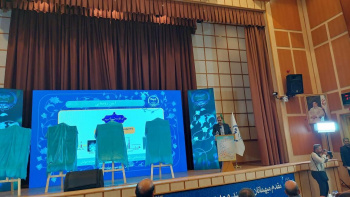filters within microchannel networks, the purity and efficiency of separating cancer cells have increased as compared to similar foreign samples. Additionally, the effects of mechanical stresses on trapped cells have been minimized."

The research team at the Motamed Cancer Research Institute has developed a diagnostic and separation kit, which has the exceptional ability to accurately detect and isolate cancer cells present in the patient's bloodstream. This kit can monitor the patient's disease status and treatment response. It is soon to be introduced to the medical equipment market in the country. Mehdi Rahmaniyan, the head of the Biomaterials and Tissue Engineering Research Group at the Motamed Cancer Research Institute, spoke about this achievement on the eve of the 43rd anniversary of the establishment of the Academic Center for Education, Culture and Research (ACECR), in an interview with ACECR’s Public Relations.
He explained, "This CTC kit has been designed and developed as part of the research project 'Diagnosis and Separation of Cancer Cells in the Patient's Bloodstream Using Microfluidic Chips for Evaluating Disease Status and Monitoring Treatment Response. The initial commercial phase of this kit has been completed, and it is currently in the process of obtaining a license from the Medical Equipment Department. Our prediction is that within the next three months, we will obtain the necessary license and introduce the product to the market."
Rahmaniyan further described the functionality of the CTC kit, stating that studies have shown that circulating tumor cells (CTCs) in the patient's blood circulation system are potential indicators for early detection, diagnosis, and treatment of metastatic diseases. However, due to their extremely low count amidst billions of blood cells, technical challenges such as low sensitivity and purity have limited the effectiveness of common separation methods. Currently, various microfluidic platforms have been developed for the separation of tumor cells circulating in the bloodstream, but scientists have not yet reached an efficient and cost-effective strategy to address this need.
Rahmaniyan elaborated on their solution: "The approach we have proposed in this field is microfluidic chip arrays based on micro-pillar arrays (MPA-Chip), containing arrays of micro-stones with a diamond shape for CTC separation. In this kit, by optimizing the arrangement of diamond-shaped obstacles as filters within microchannel networks, the purity and efficiency of separating cancer cells have increased as compared to similar foreign samples. Additionally, the effects of mechanical stresses on trapped cells have been minimized."
He mentioned that this kit has the capability to isolate one cancer cell from a 10-milliliter blood sample of the patient, and its final cost is one-tenth of the price of similar foreign kits. He stated that their research findings, published in an article in the Journal of Advanced Research with an impact factor of 12.8, have demonstrated that the diamond-shaped geometry, chosen as the most effective new design for CTC separation, led to an increase in capture efficiency (88%), purity (over 90%), and viability (97%), resulting in an overall higher performance as compared to similar foreign kits.
A member of the academic faculty at the Motamed Cancer Research Institute commented on the challenges and obstacles in achieving the completion of this project. He explained, "Considering that we possess all the technical knowledge of the CTC kit and have all the facilities and equipment available in Iran, there is no barrier for production. The only obstacle is the lack of a specific protocol for evaluating new kits in the Medical Equipment Department of the Food and Drug Organization. This issue has given rise to a slow process. I believe that the Ministry of Health, especially the Medical Equipment Department, should establish a specific regulation for evaluating new kits and equipment to expedite the evaluation process and prevent delays."
Regarding the extent of trust in the youth and the reinforcement of the “we can" spirit and the cultivation of strong scientific personalities within the ICECR, he stated, " Alhamdulillah, in the ICECR, the majority of specialized talents are young, and many responsibilities lie with the youth. This demonstrates that young individuals are paid well attention to."
Finally, in response to the question about the role that ICECR could play in advancing the knowledge-based progress of the country, Rahmaniyan expressed, "Considering that the mission of ICECR is to meet the country's essential needs and complete the connection between universities and industries, ICECR should primarily invest in high-yield and essential projects for the country to complement the fundamental projects that universities undertake."



Your Comment :